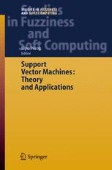Search
Search Results
-
Clustering with Intelligent Techniques
Cluster analysis is a technique for grou** data and finding structures in data. The most common application of clustering methods is to partition a...
-
Componentwise Least Squares Support Vector Machines
This chapter describes componentwise Least Squares Support Vector Machines (LS-SVMs) for the estimation of additive models consisting of a sum of...
-
Support Vector Machines for Signal Processing
This chapter deals with the use of the support vector machine (SVM) algorithm as a possible design method in the signal processing applications. It...
-
Theoretical and Practical Model Selection Methods for Support Vector Classifiers
In this chapter, we revise several methods for SVM model selection, deriving from different approaches: some of them build on practical lines of...
-
Adaptive Discriminant and Quasiconformal Kernel Nearest Neighbor Classification
Nearest neighbor classification assumes locally constant class conditional probabilities. This assumption becomes invalid in high dimensions due to...
-
Fuzzy Support Vector Machines with Automatic Membership Setting
Support vector machines like other classification approaches aim to learn the decision surface from the input points for classification problems or...
-
Cooperative coati optimization algorithm with transfer functions for feature selection and knapsack problems
Coatis optimization algorithm (COA) has recently emerged as an innovative meta-heuristic algorithm (MA) for global optimization, garnering...

-
Scene text recognition: an Indic perspective
Exploring Scene Text Recognition (STR) in Indian languages is an important research domain due to its wide applications. This paper proposes a...

-
Active-Set Methods for Support Vector Machines
This chapter describes an active-set algorithm for quadratic programming problems that arise from the computation of support vector machines (SVMs)....
-
Local Learning vs. Global Learning: An Introduction to Maxi-Min Margin Machine
We present a unifying theory of the Maxi-Min Margin Machine (M4) that subsumes the Support Vector Machine (SVM), the Minimax Probability Machine...
-
Application of Support Vector Machine to the Detection of Delayed Gastric Emptying from Electrogastrograms
The radioscintigraphy is currently the gold standard for gastric emptying test, but it involves radiation exposure and considerable expenses. Recent...
-
An Accelerated Robust Support Vector Machine Algorithm
This chapter proposes an accelerated decomposition algorithm for robust support vector machine (SVM). Robust SVM aims at solving the overfitting...
-
Unsupervised Learning Neural Networks
This chapter introduces the basic concepts and notation of unsupervised learning neural networks. Unsupervised networks are useful for analyzing data...
-
Evolutionary Computing for Architecture Optimization
This chapter introduces the basic concepts and notation of evolutionary algorithms, which are basic search methodologies that can be used for...
-
Introduction to Pattern Recognition with Intelligent Systems
We describe in this book, new methods for intelligent pattern recognition using soft computing techniques. Soft Computing (SC) consists of several...
-
Supervised Learning Neural Networks
In this chapter, we describe the basic concepts, notation, and basic learning algorithms for supervised neural networks that will be of great use for...
-
Face Recognition with Modular Neural Networks and Fuzzy Measures
We describe in this chapter a new approach for face recognition using modular neural networks with a fuzzy logic method for response integration. We...
-
Intuitionistic and Type-2 Fuzzy Logic
We describe in this chapter two new areas in fuzzy logic, type-2 fuzzy logic systems and intuitionistic fuzzy logic. Basically, a type-2 fuzzy set is...
